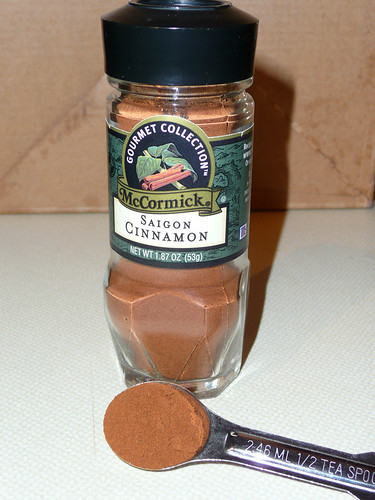Cinnamon Reduces Insulin Resistance
 There have been some studies that show that cinnamon can reduce insulin resistance.
There have been some studies that show that cinnamon can reduce insulin resistance.
ARS chemist Richard A. Anderson and co-workers at the Beltsville (Maryland) Human Nutrition Research Center assayed plants and spices used in folk medicine. They found that a few spices—especially cinnamon—made fat cells much more responsive to insulin, the hormone that regulates sugar metabolism and thus controls the level of glucose in the blood.
If it seems like you are hungry every two hours or if you constantly crave sugar or bread, you might have insulin resistance. It has been said that a dose of a 1/2 teaspoon of cinnamon a day can help reduce your cravings and correct your body’s reaction to sugar.
Several studies have shown improved insulin sensitivity and blood glucose control by taking as little as 1/2 teaspoon of cinnamon per day. Improving insulin resistance can help in weight control as well as decreasing the risk for heart disease, so this has a lot of people interested. Although the results of preliminary studies are somewhat mixed, the majority of the research seems to be pointing in the direction of cinnamon being beneficial.
But watch out, it’s possible to eat too much cinnamon. Here are some of the common negative reactions:
- Skin rashes
- Irritation to the tissues of the mouth or stomach
- Mild anti-clotting effect in the blood
- Stimulating effects on the uterus (not recommended for pregnant women)
In an effort to increase my cinnamon intake, I created this cinnamon tea, which I’m rather fond of.
- 7 ounces of boiling water
- 1/2 teaspoon of ground cinnamon
- 1 tablespoon of heavy whipping cream
Pour the boiling water into a coffee cup. Add the 1/2 teaspoon of cinnamon and mix well. This takes quite a bit of time since cinnamon isn’t easily soluble in water, but if you keep stirring, it will eventually mix into the hot water. Add the cream and continue mixing.
I keep the spoon in the cup and keep stirring between sips because the cinnamon will sink to the bottom otherwise.
Calories: 50 Carbohydrates: 0 WW Points: 1
This treat has replaced my evening sugar-free cocoa. Strangely, it tastes a little sweet, even though you don’t add any sweetener. It’s perfect for people following Weight Watchers and Atkins, since it’s low-calorie AND low-carb.
You could substitute 6 ounces of heated skim milk for the cream and boiling water to make a low-fat version with the same amount of calories. I haven’t tried this, so I don’t know how well the cinnamon would mix with milk. If you try it, leave a comment telling me how it is.
Enjoy!
Previous: The Electric Corset: 1883 Is Very Similar to 2008
Next: PostSecret: Chronic Health Problems
 Buy Walking Videos
Buy Walking Videos
June 9th, 2008 at 3:33 am
I love herbal teas! I drink tea all day long, while at work. I do it to keep myself hydrated, and also for the many health benefits they offer. As I was reading your post I was thinking, ok now I will drink more cinnamon tea, currently I am an anise and green tea kind of girl 😉
Then I wondered, ok if I drink anise in the morning, green tea around noon and cinnamon tea in the afternoon do they combine powers and become a super tea inside my body…or do they cancel each other out? Do you think it would be better do designate one day to green tea, one to anise and one to cinnamon?
That being said, I am currently at work now staring at the bottom of my cup thinking maybe all this tea is just making me crazy??
February 10th, 2009 at 10:01 pm
Its a fact and i personaly tried it in my case were i was having chol 255.06 mg/dl, HDL 36.8 LDL178 & triglycerides 203.8, Its so amaising that the intake of cinnamon powder 1gm everyday morning with milk or tea or coffie for 20 days made the levels CHOL 177.6, TRIG 99, HDL 31.4 LDL126. But the ratio between Chol/HDL is before 6.9 and now 5.6 what does this mean is it dangerous to health pls let me know.
February 12th, 2009 at 12:25 am
Total cholesterol is pretty much useless as a marker for anything. What’s important is your triglyceride/hdr ratio, as that is an indicator of the size of your LDL particles in your blood. In the first test, your ratio was 203.8/36.8 = 5.53. In the second test your ratio is 99/31.4 = 3.15. Less than 3 is ideal, anything over is an increased risk of heart disease. So the second numbers are much better.
February 25th, 2011 at 3:48 pm
For people with blood clot issues there is a very distinct difference between cassia cinnamon and ceylon cinnamon. Cassia is what you pick up at the grocery store. The problem with this that the cassia has high levels of an anticoagulant in it. ie it has something in it that prevents blood from clotting. [see therenegadehealthshow.com episode 561]. You want to go with the ceylon cinnamon. it is the better quality cinnamon [alton brown “good eats”]. it can usually be found in health food stores. In response to Nadine’s tea question I would say green tea has caffine in it. And it isn’t the best for you because of how the tea is proccessed before consumption. the caffine in the tea interfers with your attempt at hydration. it will inhibit the proccess. hence why athlets don’t drink stuff with caffine in it to hydrate. my source on this was an exercise physiology textbook and class take. the book was published post 2006.